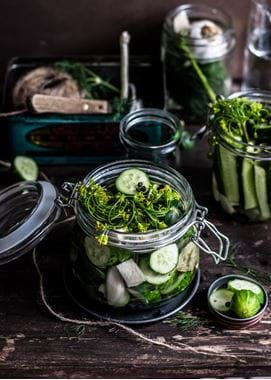The gentle balance of food preservation
The gentle balance of food preservation
Seasons change, and foods change with them. But today, we’re used to buying apples in June and strawberries in December; our egg supply shouldn’t dwindle, and when we travel to far off places (or think about it), we rarely consider how not to starve on the way.
For much of the past, none of this was so. Preserving foods from the good times to tide over the bad was built into the daily routine of hunting, growing and cooking. Our modern understanding of preservation is built on the work of Victorian scientists who discovered micro-organisms: exclude or kill those organisms and food will last. But it wasn’t necessary to know why or how something worked to know that it did. The simplest and earliest method was drying; pulses were one of the first things to be dried and archaeologists have found dried lentils stored from the Neolithic era. Fish, meat, fruit and vegetables were also preserved by air drying, often with the addition of salt, the exact techniques varying by culture and geographic location.
Meat was a focus – prestigious as well as nutritious – and different cultures developed highly specific preservation methods. In North America, there was pemmican: dried meat mixed with fat and berries. South Africa had biltong; South America had jerky. In Britain, hams were made by brining and hot-smoking meat, using highly regionalised recipes. Most were pork, but there are also recipes for mutton, beef, badger and even small bear. The process of making them was often a community affair, with the curing and smoking taking several weeks before each ham was wrapped in cloth and hung up to mature.
But food preservation has always been about more than just survival. Smoking and salting add flavour, and by the 17th century, as farming improvements alleviated seasonal supply issues, preserved foods were valued for this as much as for their longevity. Pickling became popular. One recipe for pickling larks took six months, dissolving the bones in the process. Pickles were made with beer, wine or vinegar plus herbs and spices, and were used for everything from brawn to beans, which would then keep for months, if not years. And it was only a short step to using the liquid itself – as ‘catsups’ (otherwise known as ketchup) or essences such as Worcestershire Sauce.
For fruit and vegetables, preservation could transform the quotidian into something magical. Strings of dried produce were practical and beautiful – citrus was highly prized as lemons and oranges were expensive, while Louis XIII of France threaded mushrooms onto strings. When sugar became fashionable, candied fruit became a sign of sophistication and wealth. Flowers brushed with whipped egg white and sprinkled with fine sugar were dried in a low oven overnight: a heady mix of colour, texture and flavour. Then came marmalades. The word comes from the Portuguese ‘marmelo’ – quince – from whose honeyed flesh the earliest examples were made. By the 19th century, jams were a mainstay of any kitchen. Chutneys, meanwhile, were adapted from Indian recipes, sometimes with an optimistic view of the English climate – one recipe read ‘put in the sun every-day for a month’. Jars were sealed with pigs’ bladders, stretched and dried. Even this took time – a couple of weeks to dry out fully.
By the 20th century, there was no real need to preserve foods in these ways. The fridge, the freezer and the supermarket gave us food at our fingertips. But industrial versions of slow-preserved foods don’t always have the flavour, and we can lose touch with the way our food is produced. So while we shouldn’t rose-tint the past, we can still appreciate that time itself adds value, and that sometimes the best things really are worth waiting for.
Dr Annie Gray is a food historian and the author of several books, including ‘Victory in the Kitchen: The Life of Churchill’s Cook’. She’s also a broadcaster, consultant and keen pickle-maker.







